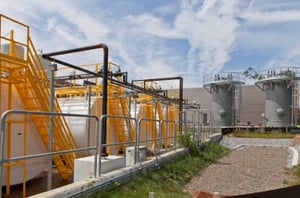Our nation’s electrical grid is an awesome creation that has transformed the landscape and brought prosperity to hundreds of millions. As an engineer, I am awed just thinking about the sheer scale of it and the countless hours of work involved in its conception, design, and construction.
For all its complexity, however, only about 29% of the energy in the fuel that is used to produce electricity actually reaches our homes, businesses, and factories. What’s more, once the power is used for lighting, computers, and other tasks, we require even more electricity to remove the heat these devices produce. And finally, for much of the year, we burn additional fuel within our homes and buildings to keep warm.

We need to do better than this. By 2040, worldwide energy demand is expected to increase by 56%. This represents hundreds of new plants that will need to be constructed in the next two decades. This need will be even more acute since much of our current generating capacity is aging and already operating beyond is originally-anticipated life. The new generation of plants will need to be more efficient than today’s, and we must find better ways to conserve energy at its ultimate point of use.
Cogenerations, also known as combined heat and power (CHP), or combined heating, cooling, and power (CHCP) can utilize the waste heat from fuel-fired generators to produce steam or hot water. The heat is then used directly to provide space heating, or it may be used to drive a desiccant-based cooling process such as absorption chillers. (There are many other permutations of this, but CHP and CHCP are the most common outside of industrial occupancies.) Cogeneration can significantly reduce energy use and emissions, bringing the overall fuel efficiency to over 60%. We have designed plants ranging from a few megawatts at U.S. Embassy compounds to the soon-to-be completed 25 MW plant at the Food and Drug Administration’s headquarters in White, Oak Maryland.
But we need to look at cogeneration as only a piece of a larger strategy for meeting our energy needs. Energy districts can be created to serve densely-occupied areas such as bases, urban zones, and campuses. These districts take advantage of the differing load profiles of building types served and can be integrated with a number of other heating and cooling strategies. The energy districts will produce power and at the same time serve as the primary source of heating and cooling for all the buildings.
Depending on a variety of factors including climate, available space, and geology, district-wide ground-source heat pump loops may offer the most efficient means of heating and cooling of buildings in the energy district. A single heat pump loop connected to deep, closed-loop wells and surface ponds can be routed throughout the entire district. Each building served by the loop would utilize either high-efficiency packaged water-source heat pumps or reversible chillers so they can produce heating and cooling as necessary. By tying all buildings into the district heat pump loop, heat may be easily transferred among internal zones and dissimilar occupancies.
The energy district’s central plant would contain the primary distribution pumps for the district loop and would also modulate the loop temperature should it get too hot or cold by using heat recovered from the power generation process.
An interim goal for an energy district is to get to the point where NO fossil-fuels are consumed for space heating and production of domestic hot water as the heat can be transferred from other areas of the district that require cooling or by reclaiming waste heat from power generation. Once the efficiencies of the building and the central plants serving them are maximized, renewable energy systems such as photovoltaics (PV) can be incorporated to move the entire district toward the ultimate goal of net zero energy use.
All of this would be a relatively straight-forward economic exercise were it not for the looming issue of climate change. While few topics generate more debate, there is ample scientific evidence to support that it is occurring and is the result of human activity (the burning of fossil fuels). Today and for foreseeable future, any analyses assessing the viability of power generation on a local or municipal scale must also include a comprehensive study on the emissions and their potential to increase CO2 and pollution in general. Efficient energy generation using the latest technologies and employing renewable energy where practical can significantly reduce emissions from the business-as-usual approach.


